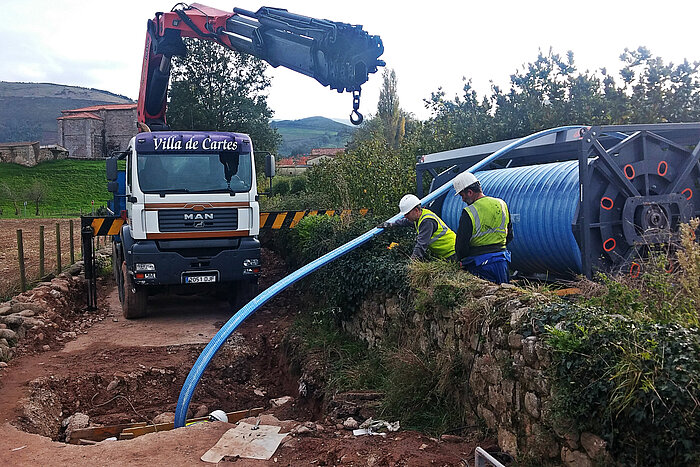In the heart of Cantabria close to the Atlantic coast in the north of Spain, there is the municipality of Reocín. A wide pipe system supplies water to the about 15,000 inhabitants. During the holiday seasons, the water demand in this tourist region even rises considerably. The water is taken from the river Saja, treated in a corresponding plant in Ruente and transported to the municipal reservoirs via an asbestos cement water pipe with a length of about ten kilometres.
The asbestos cement main was constructed in the 1950s and was in a critical condition: It had various breaks which led to a loss of water of up to 25 %. Frequent interruptions in water supply were the consequence. The regional government of Cantabria that is responsible for infrastructure and water supply therefore recommended to restore the pipe immediately.
The original plan was to replace the piping by means of an open trench installation. But this would have implied to dig up the ground for several kilometres in order to install the new pipes and to use heavy duty equipment in the area of the nature park Saja – a living space with brown bears, wolves and eagles as well as enormous richness in fish. This would have been a severe impact on this sensitive ecosystem and would moreover have taken one year. Therefore, the responsible persons of Cantabria’s water board decided to look into trenchless rehabilitation solutions.
Trenchless rehabilitation with Primus Line® as alternative
In the course of the study, the water board also evaluated the Primus Line® system for suitability and application. The result: Primus Line® reduced the construction period from twelve to four months, i. e. to a third. The costs dropped by 30 %. Consequently, the water board favoured a change to trenchless technology. After the tendering phase, the contract was awarded to Dragados S.A. who commissioned the Spanish Primus Line® partner Sinzatec to carry out the rehabilitation work on the water main.
Sinzatec rehabilitated the existing water main DN 250 consisting of asbestos cement on the largest part of the section and of PVC at the end. Sinzatec’s team inserted a liner of the type Primus Line® DN 250 PN 15 in the asbestos cement host pipe on a length of 9,850 metres. Due to reasons of space, the diameter in the PVC pipe reduced to Primus Line® DN 200 PN 18 on a length of 495 metres while the operating pressure was maintained. On the total stretch, Sinzatec installed sixty Primus Line® low pressure connectors with DN 250 and four with DN 200.
This extensive project required careful planning. Routing as well as restoration of individual pipe elements such as drains and existing supply services were taken into consideration. This action finally resulted in twenty installation sections with varied lengths from 161 to 908 metres. The average section measured between 500 and 600 metres.
Most extensive trenchless pipe rehabilitation project in Spain
For the water supply during the installation period of Primus Line®, Sinzatec tapped the connection between the pipe to be rehabilitated and a subterranean aqueduct. Thus, it was possible to rehabilitate a section of seven kilometres without additional by-pass line. For the last three kilometres, the Sinzatec team mounted a by-pass before inserting the liner section by section.
On its ten kilometres, the rehabilitated pipe passes most various environments: It crosses bridges and motorways, streets and railways, urban areas and uncultivated landscapes as well as woodlands and pastures. In doing so, it overcomes diverse elevations and masters bends of up to 45 degrees.
This project is the largest realised in Spain with trenchless technology so far. With an installation time of just four months, it highlights the benefits of using trenchless solutions such as Primus Line® for the full rehabilitation of supply lines.



